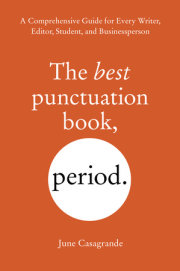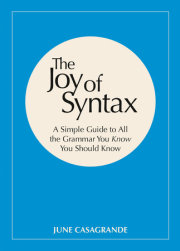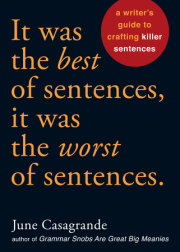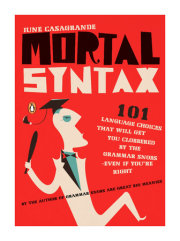Introduction: Punctuation Is Easy, Except When It’s Not
Punctuate this:
In general the writer who did well in college earning As and Bs knows that a young aspiring middle grade novelist has an equally good reason to join the writers group because what it is is a line up of super creative people who for conscience sake treat it like a sub group of their audience to gauge the readers sensibilities and practice copy editing something they started in the 1960s and 70s because it was in the founders words far out
Did you put a comma after
in general? Did you put commas after
writer,
college,
Bs, and
group? Did you put apostrophes in
A’s,
B’s,
writers’,
conscience’,
readers’, ’
70s, and
founder’s? Did you put hyphens in
middle-grade,
super-creative, and
sub-group? Did you put a dash before
something? Did you put quotation marks around
far out but insert a period between the word
out and the closing quotation mark?
If so, your passage probably looks a lot like this:
In general, the writer, who did well in college, earning A’s and B’s, knows that a young aspiring middle-grade novelist has an equally good reason to join the writers’ group, because what it is is a line up of super-creative people who for conscience’ sake treat it like a sub-group of their audience to gauge the readers’ sensibilities and practice copy editing—something they started
in the 1960s and ’70s because it was, in the founder’s words,
“far out.”
And you might think your polished, carefully punctuated passage is perfect. But you’d be wrong.
The
Los Angeles Times would disagree with your apostrophes in
A’s and B’s. Per that newspaper, it should be
A’s and Bs.
The Chicago Manual of Style would disagree on different grounds: in that style, it should be
As and Bs. Any book editor would swiftly change your
copy editing to
copyediting. Then there’s your punctuation of
“far out.” Most editors outside the United States would swap the places of your period and closing quotation mark.
It gets worse: your punctuation marks could even be creating factual errors.
The writer, who did well in college refers to someone different than does
the writer who did well in college. That comma changes the identity of the subject and even the number of people it represents because
the writer who did well in college can refer to every student who did well in college.
Are you really sure that just one founder called it
far out? Or could those be the
founders’ words? How sure are you that you’re talking about
the readers’ sensibilities and not
the reader’s sensibilities? Are you certain you want to leave
line up as two unhyphenated words? Are you confident that an em dash is a better choice for setting off that final thought than parentheses or a colon? How would you explain your choice to leave a comma out of
what it is is?
How would you feel if, after leaving a comma out of
young aspiring middle-grade novelist, you saw a highly respected publication use the same phrase except with a comma after
young?
On the surface, punctuation is simple stuff: a system of clear, well-documented rules we all learned in school. But when you sit down to write an article or a story or a business email or a blog post, suddenly it’s not so simple. One after another, situations arise in which the basic rules you thought you knew are no help at all. If you start looking for answers, it can get even more confusing. One of the most well-respected and influential style guides in the country will tell you to put just one comma in
red, white and blue. But if you take that as gospel, you’ll be lost when you notice that nearly every book you pick up prefers to throw in another comma before the
and, writing it
red, white, and blue.
And heaven help you if you start paying attention to how professional editors use hyphens. The truth is, punctuation can be very difficult. Professional writers don’t know it all. Even professional editors look things up, debate them with colleagues, and are sometimes still left guessing.
No one knows everything there is to know about every punctuation mark, and no one is expected to. But that leaves any amateur or professional writer to ask:
So what am I expected to know? Will I look stupid if I put a comma here or an apostrophe there? Or do even professional editors share my confusion on this matter? A lot of people assume that there’s a single correct answer for every punctuation conundrum. Either a comma belongs in a certain spot or it doesn’t. Either the possessive of
James is formed by adding an apostrophe plus an
s, or it’s formed by adding the apostrophe alone.
The good news here is also the bad news: often there’s more than one right answer. Whether to use a certain punctuation mark can be a matter of choice—the writer’s way of emphasizing his meaning, creating rhythm, or making the words more pleasing to the eye. Other times these questions boil down to a matter of style—the kind with a capital
S that’s laid down by one of the publishing world’s official playbooks. Still other times, there is only one correct choice, and if you fail to choose it, you can inadvertently change your meaning.
The goal of this book is let you punctuate every sentence, even those that fall into the gray areas of punctuation rules or style differences, with complete confidence.
Copyright © 2014 by June Casagrande. All rights reserved. No part of this excerpt may be reproduced or reprinted without permission in writing from the publisher.












